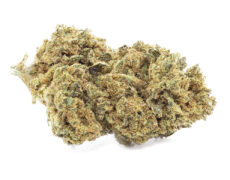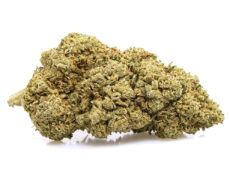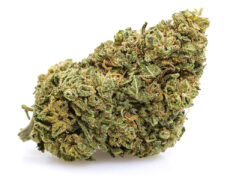Modified on: 10/02/2024
EXPLORING OUR ECOSYSTEM THROUGH TERPENES, THE MOLECULES WITH A THOUSAND FUNCTIONS AND SCENTS
If you’re a cannabis plant enthusiast and often wonder about the source of its therapeutic effects, then terpenes should be at the center of your attention. Terpenes, in fact, are found in the resin of many plants (herbs, spices, fruits, and vegetables). When these plants are processed and transformed, terpenes remain in foods, essential oils, and derived products. They are organic compounds that can also be found in soaps and detergents, perfumes, cosmetics, and various types of products.
These small natural molecules are the true artists behind the scents that surround us, the scents that give life to your favorite flowers and the plants that populate the world. In this article, we will delve into the world of terpenes, discovering what they are, what they are used for, and where you can find them.
-
 SMALL & BIG
SMALL & BIGBUBBLEGUM
Indoor | CBD – CBDA < 22%
Starting from:EASTER SALE -10%
1,25CHF1,10CHF/gGrams3 5 10 20 50 100 -



DO SI DOS
Starting from: 2,00CHF/gIndoor | CBD – CBDA < 19%
Grams3 5 10 20 50 100 -



ROYAL GG#4
Starting from: 2,30CHF/gIndoor | CBD – CBDA < 40%
Grams3 5 10 20 50 100 -



GORILLA GLUE
Starting from: 2,90CHF/gIndoor | CBD – CBDA < 20%
Grams3 5 10 20 50 100
The Chemical Formula C10H16
During the nineteenth century, research on the chemical constituents of essential oils led to the discovery of numerous isomeric hydrocarbons with the formula C10H16, which were called terpenes.
So it’s clear that terpenes are composed of carbon and hydrogen atoms. Widely distributed in nature, they serve a myriad of events and purposes, especially for the ecosystem. Imagine walking in a pine forest or biting into a juicy mango: those scents that strike your nose are the result of terpenes in action.
Terpenes are built from isoprenic units. Depending on the number of isoprenic units, terpenes are represented by the general formula C5H8.
But depending on the number of isoprenic units, you can have monoterpenes, C10H16, formed by the condensation of two isoprenic units; sesquiterpenes, C15H24, formed by 3 isoprenic units; diterpenes, C20H32, formed by 4 isoprenic units; triterpenes, C30H48, formed by 6 isoprenic units; tetra terpenes (carotenoids), C40H64, formed by 8 isoprenic units, and so on, and in each of these classes, acyclic and cyclic structures can be distinguished.
In nature, there are more than 30,000 different types of terpene compounds, and their chemical structure can vary significantly. These aromatic compounds can be found throughout the plant kingdom, from flowers to herbs, from flowers to tree resins. But why did nature create these aromatic substances? What do terpenes do?
Read also: Depotentiated marijuana. What it is and what it is used for


C5H8: The Secret Chemical Formula
In the fascinating world of terpenes, there are chemical secrets that give cannabis plant its unique aromas and flavors. At the heart of this chemical magic is a simple but powerful formula: C5H8.
C5H8 represents a chain of five carbon atoms and eight hydrogen atoms, but it is its three-dimensional arrangement that gives rise to an extraordinary variety of terpenes. Every small change in atomic structure can lead to a completely different terpene, with a unique aroma and taste.
These terpenes are not only responsible for the distinctive aroma of different cannabis plant varieties but may also influence the experiences of users. Some terpenes are known to have potential therapeutic effects, such as myrcene, which could promote relaxation, or limonene, which could increase energy and well-being.
So, while C5H8 may seem like just a small thing, it is actually the key to understanding the complexity of cannabis plant scents and flavors. These terpenes contribute to creating a mosaic of sensory experiences for those who appreciate this extraordinary plant.
The Key Role of Mevalonic Acid in Terpene Production
Cannabis is a fascinating plant that has captured the attention of scholars and herb enthusiasts for many years. One of the most intriguing features of this plant is terpenes, aromatic compounds that contribute to the unique aroma and flavor of different varieties. But how are these terpenes produced? Mevalonic acid plays a crucial role in this process.
Mevalonic acid is a fundamental chemical compound for the biosynthesis of terpenes in cannabis. This acid is a precursor in the production chain that leads to the formation of terpenes, which are then released by the plant in small glands called trichomes. Terpenes are responsible for the wide variety of scents and flavors found in different cannabis varieties, ranging from the earthy and woody aroma of humulene to the fruity and sweet scent of limonene.
What Are Terpenes Used For ?
They serve many purposes, but their main task is to protect plants. They are like chemical guardians of nature. Here are some of the key roles they play:
1. Defense against Predators : Some terpenes emit unpleasant odors that repel insects and animals that could harm the plant. This defense mechanism helps plants survive and thrive.
2. Attraction of Pollinators: On the other hand, some terpenes produce delightful fragrances to attract insects, birds, and other animals that aid in pollination. This is essential for the reproduction of many plant species.
3. Temperature Regulation: Terpenes can influence the density of fog around plants, helping to regulate temperature and protect against excessive sunlight.
4. Chemical Communication : Plants use terpenes to communicate with each other. When a plant is under attack by parasites, it can release terpenes that alert those nearby, allowing them to prepare for defense.
5. Aromatherapy: Terpenes are used in aromatherapy for their relaxing and therapeutic effects. Fragrances like lavender and eucalyptus owe their benefits to the action of terpenes.
Where Do We Find Terpenes?
Terpenes are everywhere, even if you might not realize it. Here are some common places where you can find them:
1. Plants and Trees: They are the primary source of terpenes. You can find them in flowers, leaves, bark, and even roots. Think of the scent of rose flowers or pine essential oils – they are all rich in terpenes.
2. Fruits and Vegetables: If you’ve ever smelled a ripe strawberry or a slice of lemon, you’ve had a taste of the terpenes present in these foods. Terpenes help define the taste and aroma of many fruits and vegetables.
3. Essential Oils: Oils are concentrates of terpenes extracted from flowers. They are used in perfumery, cosmetics, and aromatherapy for their health and wellness benefits.
4. Hemp: Perhaps one of the most debated places to find terpenes is in cannabis. Each variety of weed has a unique combination of terpenes that contributes to its aroma and effect. For example, myrcene, a compound of the terpene class, imparts an earthy scent, while limonene, another compound, imparts a citrusy aroma.
5. Cleaning Products and Perfumes: Many home fragrances and cleaning products contain synthetic or naturally-derived terpenes.
Additionally, if you love wine, you’ve probably heard that the scents of this beverage develop thanks to the presence of terpenes, which, combined in various ways, give wine its characteristic fruity, herbaceous, alcoholic, or animal aromas, and so on.
In essence, terpenes are everywhere in nature and in our daily lives. Without them, the world would be much less fragrant and flavorful.
But what’s the correlation between cannabinoids and terpenes ?
First and foremost, hemp is a plant, so like any other in nature, it has its share of terpenes inside, causing its unique and recognizable scent among thousands of others. Marijuana contains over 120 compounds of this type, and it’s the combination of these volatile substances that determines its distinctive aroma. Different combinations give rise to different types of weed, each with its own peculiar fragrance and qualities. But that’s not all ! Terpenes also have the ability to act in synergy with marijuana extracts, enhancing their benefits. This characteristic has been the subject of several studies, which have highlighted in particular the important “entourage effect.”
This effect is simply the term used to describe the synergistic work between phytocannabinoids and terpenes in marijuana, a complementary action between these elements contained in natural cannabis extracts that can enhance the therapeutic index of preparations and thus broaden their field of use.
The characteristics of these compounds contained in marijuana, such as the final quantity and type, fundamentally depend on the same factors that affect the health and growth of plants : soil type, climate, fertilizers used, and the age of the specimen.


Terpenes in Cannabis: A Perfect Match
These aromatic molecules found in cannabis also, are produced by the resin glands of the plant, where they accumulate together with cannabinoids such as THC and CBD. In practice, these compounds, in combination with cannabinoids, are capable of enhancing their therapeutic potential, as if they were a kind of “natural amplifier.” Specifically, the main property of these organic compounds is to enhance the beneficial effects of CBD and THC.
Primarily, the field of action of terpenes on cannabis positively affects the immune defenses, mood, and relaxation state but without causing psychotropic reactions (they do not produce the so-called “high” effect). This is why they are absolutely safe, legal, and 100% natural substances.
What are the different roles of terpenes in Cannabis ?
These organic compounds in weed (or hashish) play several important roles, most of which are consequences of their presence:
Aroma and Taste : They are responsible for the distinctive aroma of each cannabis variety. For example, limonene imparts a citrusy scent, while myrcene imparts an earthy aroma. These scents not only define the sensory experience but can also influence taste perception.
Therapeutic Effects: In addition to aroma, they also contribute to the therapeutic responses of cannabis. Some terpenes may have sedative or relaxing properties, while others can be energizing or anti-inflammatory. The combination of these organic compounds and cannabinoids creates what is known as the entourage effect, where different molecules work together to produce unique results.
Distinguishing Different Varieties: They play a crucial role in distinguishing different hemp varieties. This is particularly important in legal markets, where knowledge of terpene composition helps consumers choose varieties that best suit their needs and preferences.
Attracting Pollinators: Although hemp is not pollinated by the typical bee, these compounds in the flowers attract insects that can help distribute pollen.
Read also: Smoking oregano: an overview of possible side effects, benefits, and procedures
Understanding the Role of Terpenes in Cannabis
Cannabis plant is a complex plant that contains a vast array of chemical compounds, with cannabinoids and terpenes being two of the most prominent. Cannabis terpenes and many other plants, are aromatic compounds that play a crucial role in the effects of THC and CBD.
Terpenes may enhance the therapeutic properties of cannabinoids, offering potential health benefits. They are volatile compounds that give cannabis strains their unique flavors and scents. Some of the popular cannabis strains, like cannabis sativa and hybrid strains, are known for their distinct terpene profiles.
Caryophyllene, α-humulene, and other terpenes found in cannabis have medicinal properties. They interact with the human body’s endocannabinoid system, providing a wide range of medicinal benefits. Terpenes could also have antibacterial properties and affect certain immune cells.
In the cannabis industry, full-spectrum cannabis extracts, which include both cannabinoids and terpenes, are highly sought after. This synergy is believed to create an entourage effect, enhancing the therapeutic benefits and reducing potential side effects.
Cannabis terpenes, when combined with cannabinoids like cannabidiol (CBD buds) and tetrahydrocannabinol (THC), can create a more balanced and nuanced experience. Terpenes enhance the effects of THC and CBD, influencing the psychoactive effects and therapeutic potential of different cannabis strains.
Moreover, cannabis terpenes are not unique to this plant ; they are also found in various other plants and essential oils. For example, α-humulene is found in hops and can contribute to the distinct aroma of beer.
In summary, the world of terpenes is vast, with many cannabis terpenes, but also in other plants and essential oils. They are a vital component of the cannabis plant’s appeal, both for its recreational and medicinal use, and hold significant potential for the future of clinical cannabis and medicinal benefits.
Examples of Terpenes in Cannabis : Some Types
Here are some examples of common terpenes found in cannabis and their characteristics:
Myrcene: Present in various plants, myrcene imparts an earthy aroma and may have sedative properties.
Limonene: Found in citrus fruits like lemon and orange, limonene provides a fresh aroma and may have antidepressant and energizing properties.
Pinene: As the name suggests, pinene is found in pine trees and emits a forest-like scent. It has anti-inflammatory properties and can improve memory.
Caryophyllene: This terpene has a spicy aroma and is found in herbs like black pepper. It has anti-inflammatory properties and may help reduce anxiety.
As seen, terpenes are rich in important health properties, which is why there is such a wide range of derivatives: many exploit their therapeutic virtues to a greater extent (both for local and internal use), while others specifically focus on their aromatic properties, as mentioned earlier.
Conclusion
In conclusion, terpenes are an essential part of the natural ecosystem that surrounds us and many of the products we use in our daily lives because, without realizing it, they play a fundamental role in defining the smells and tastes we perceive around us. They serve not only to protect the ecosystem but also to influence our mood and well-being through aromatherapy. And above all, terpenes are an integral part of the cannabis experience, defining its aroma and reactions in the body. Understanding terpenes in cannabis is essential for enthusiasts and consumers looking to personalize their experience with this extraordinary plant.
At Justbob, we always rely on reliable sources to provide you with the best information on the topics that matter to us. If you’re interested in these topics, browse our blog and immerse yourself in the aromas of cannabis, hashish, or CBD oil!







